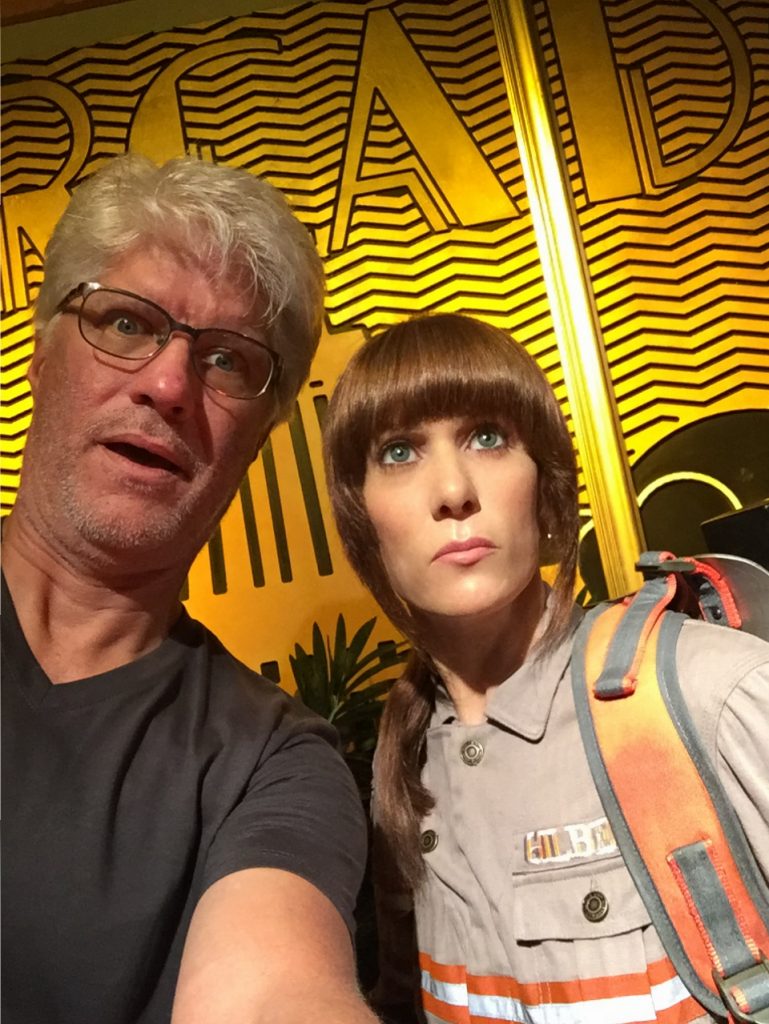 Into the Void
Into the Void
A Review of Ghostbusters: Dimension
by Bob Cooney
Virtual Reality is finally catching up with our dreams and expectations. There’s been amazing hype surrounding new VR products like Oculus Rift, Playstation VR, HTC Vive and other consumer gaming products. If you are a passionate gamer and have a few grand to drop, you can pick up a high-end gaming computer, a head-mounted display (HMD) and a room-scale tracking system and give it a go. The problem is you’ll still be tethered to your computer, and limited to slight movements in a small 8 x 8 foot space.
To truly experience the wonder of VR, you need more room and some serious computing power. There are two companies on the forefront of this revolution: The Void and Zero Latency. The Void made news in 2015 when they announced their intention to create a virtual theme park, raising tens of millions of dollars from Chinese investors. Over the last year they’ve held private beta tests at their headquarters in Salt Lake City, Utah, as well as a highly publicized demo at TED that Steven Spielberg exclaimed was “A Great Adventure.”
The Void recently announced that they were opening their first retail installation in conjunction with Madame Tussauds (the famous wax museum) and Sony Pictures. Installed on the seventh floor of the Times Square location of Madame Tussauds, “Ghostbusters: Dimension” promised a “hyper-reality” experience combining real-time physical effects, or haptics, on a physical set while wearing a customized VR rig so you feel what it is like to be a Ghostbuster, tracking and trapping a supernatural foe through a New York apartment complex with a proton pack and gun. I recently set out to see if it lived up to their promotional material and my expectations.
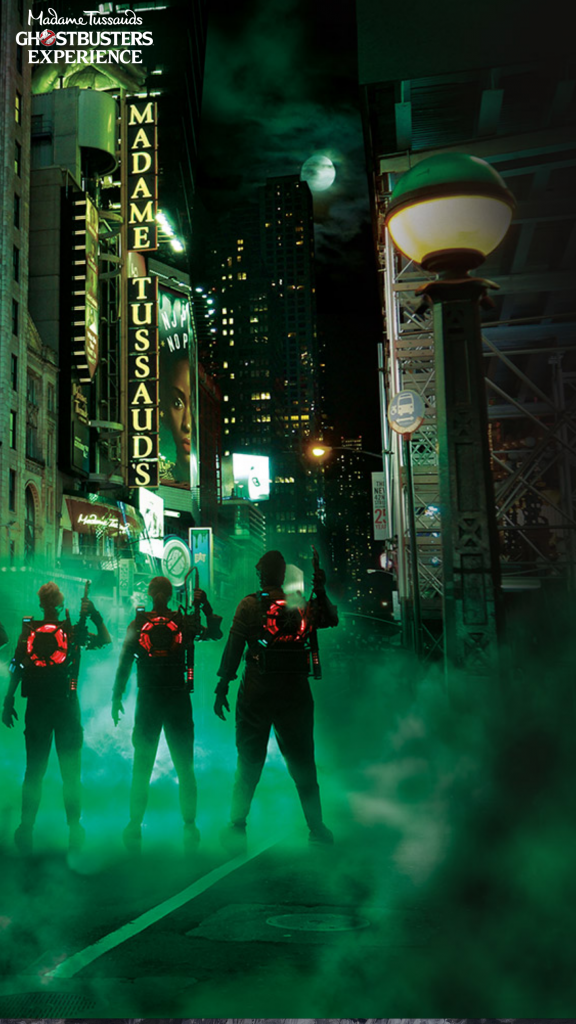 As you might know from reading my previous articles, I’ve been around VR since 1991 when Edison Brother’s Mall Entertainment asked for my help introducing their new Virtuality Entertainment System at IAAPA in Orlando. I was launching Laser Storm laser tag system at the time, and EBS was my biggest customer. Okay, they were my only customer at that time, but whatever.
As you might know from reading my previous articles, I’ve been around VR since 1991 when Edison Brother’s Mall Entertainment asked for my help introducing their new Virtuality Entertainment System at IAAPA in Orlando. I was launching Laser Storm laser tag system at the time, and EBS was my biggest customer. Okay, they were my only customer at that time, but whatever.
We went on to open several high-profile Laser Storm/Virtuality entertainment centers together across America to incredible press reviews and long lines of customers. Later that decade, I joined an early stage startup called Global VR and helped launch the VR Vortek, the first commercially successful virtual reality coin-op arcade game. Based on my history, I was a little dubious about this third wave of VR when the Oculus Rift launched on Kickstarter, as the first two were fairly short-lived. For VR to go from a curiosity to a trend and ultimately a phenomena, there needs to be continuous innovation as opposed to the fits and starts of the last 25 years.
I already experienced all the commercially available VR systems that were promoting themselves as the next best thing, with the exception of The Void. They had invited me to check out their demonstration in Salt Lake City, but my schedule just never aligned with theirs. My recent trip to New York afforded me the opportunity to drop in unannounced to see what they were up to.
Now for full disclosure, during research for my article on VR in RePlay, I traveled around the world (literally) and tested all the other “free-roam” VR systems. The one I was most enamored with was Zero Latency in Melbourne, Australia. Since the publication of that article, I’ve gone to work for them as a consultant, helping bring their system to the North American market. Despite my relationship with them, I will endeavor to make this review as impartial as possible.
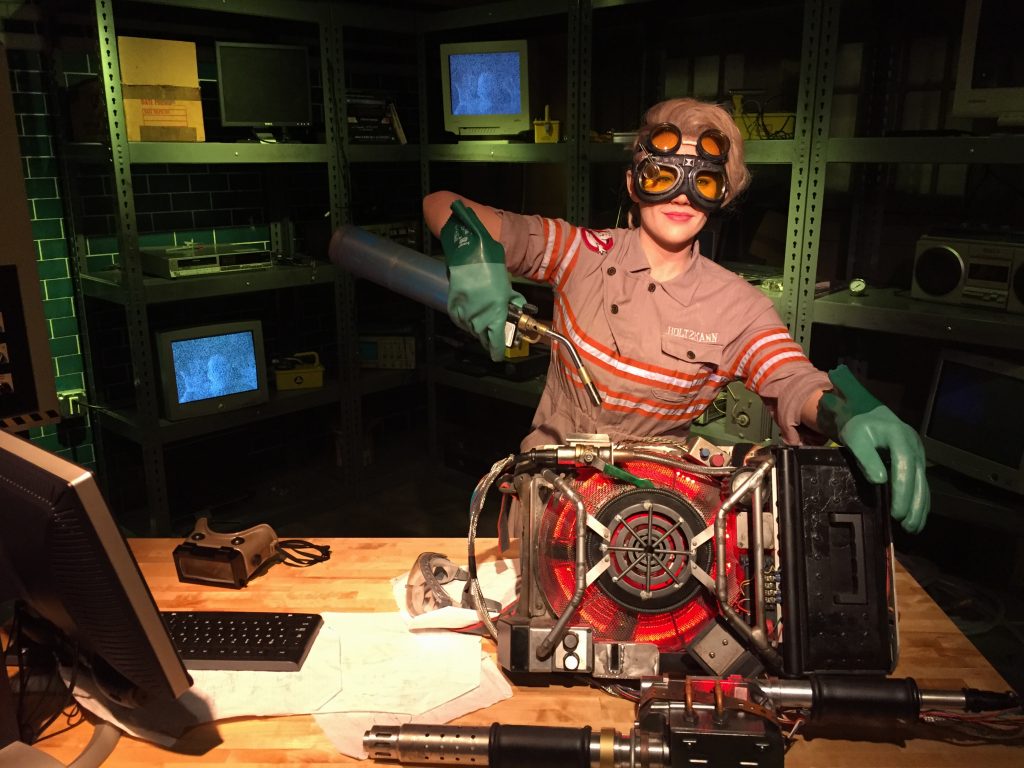
Who You Gonna Call?
When I first decided to go to NYC, I went online to see if I could even get tickets to the Ghostbusters: Dimension experience. I was somewhat surprised that I was able to book tickets for any day or time I wanted (Zero Latency had been selling out four to six weeks in advance since they opened last August). The Madame Tussaud’s website allowed me to book as many tickets as I wanted for any time slot, which was bizarre as the experience was positioned as a three-player experience that took 15-minutes. Nevertheless, I purchased five tickets for me and some friends for 6:45 p.m. on Tuesday, July 5.
My friends also happen to be amusement industry luminaries. Second generation FEC operator Michael Getlan (Amusement Consultants) and his son Issac; Apple Industries’ Allen Weisberg and Vending Times’ Alicia Lavay agreed to join me for the VR fun.
We met in the lobby of Madame Tussaud’s at the allotted time and were told the fastest way to the Ghostbuster’s Experience was to take the elevator up to the ninth floor, and then work our way down to the seventh. The elevator deposited us in a room with amazingly realistic wax replicas of movie stars. After some selfies and a stop at the bar, we worked our way through the hall of Presidents, some dioramas of Lucille Ball, Don Draper from Mad Men, and various other celebrities. We finally came to the staircase that led us to “the NYC Subway” where our Ghostbuster’s adventure was to begin.
Madame Tussaud’s has done a fine job of recreating the ambiance of the Ghostbuster’s universe. From free-floating apparitions of Slimer projected onto a fog screen to a full holographic display of a ghost being captured, the overall exhibit was well done. As we descended the stairs at the end of the hall we saw a crowd gathered for what must have been The Void experience.
I approached a young woman behind a pedestal with a computer and showed her my tickets. She found my party on her clipboard. As I counted about 20 people in the waiting area I asked how long the wait was.
“About an hour and 45 minutes”, she replied sheepishly. I did the math in my head. Three people per game, seven-minutes of in-game experience…seven games at seven minutes should be about an hour accounting for the inefficiencies of a new operation that was in just its fourth day of operation.
“Hmmmm. That’s a problem, as I had a 6:45 reservation.” She shrugged as if I was’t the first person to express my disappointment. When I asked if we could wander around while we waited, she said we’d lose our place in line, this despite having a “reservation.” I asked to speak to the manager and he quickly refunded my original $20-per-ticket purchase and offered to let us continue to stand in line if we wanted to wait.
I’d come all this way, dragged four friends with me and really wanted to see how The Void differed from Zero Latency. So we waited. The wait was long and the air in this corner was stagnant, making for a miserable wait and pretty grumpy people. By the time we got into the attraction it was 9:30 p.m. Keep in mind our “reservation” was for 6:45.
About halfway though the wait period an attendant came up to us and asked us how many were in our party. She was putting people in groups of four. “I thought the attraction was designed for three people?” I questioned. “Well, we’re trying to move people through faster because the wait is so long,” was her response. I wondered how that would effect the experience. I’d find out soon enough.
While we were waiting, I decided to do some research. I interviewed everyone in line and everyone leaving the game. My questions were simple:
Were they local or tourist? All locals. As I suspected.
Did they come to experience The Void specifically, or the entire museum? Every one was there to experience The Void. Which means they were paying $50 plus the cost of getting there (either train or $50 to park) and dealing with the hassle factor of coming to Times Square in the summer.
And they were mostly Millennials aged 22-35 with a few pushing 40 years old. There were two young kids (maybe 12) out of about 40 people I viewed. This is consistent with what I have viewed in my experience with Zero Latency.
As people exited the game I asked them if they liked it. Nearly everyone said yes with a big grin. There were a few specific complaints that I will address in a minute. But as for the overall satisfaction rating of the in-game experience I have to give it a 100%.
I then asked if they thought it was worth the $50 price for what amounted to a five-minute game. Without hesitation, everyone said yes. Again, based upon my experience in Melbourne with Zero Latency, I was not surprised at all.
I asked if it was worth the wait and this is where there was a split response. A few said yes, but most emphatically said no. I believe this has as much to do with expectation setting as it does actual value. Haven’t we all waited two hours for rides at Universal or Disney (hello Harry Potter)?
When I asked if they would pay to do it again, nearly everyone said yes, but not for $50, and they definitely would NOT wait in line again for two hours. Consensus on price for a repeat play hovered around $20 per person, which is still $4 a minute for an in-game experience. That’s unprecedented in out-of-home amusements as far as I can tell.
Getting Ready to Go…At Last!
Our time was finally approaching. We were ushered into a room where the equipment was hung on some very fancy counterbalanced overhead hook mechanisms, which made getting in and out of the vest almost self service.
They’ve made some odd choices with the equipment. The clasps on the vest were unlike anything we had seen before, and we all needed instruction on how to buckle them which slowed things down. Due to the built-in, force-feedback haptics (what aids in the sensory experience) the vest was extremely heavy. The helmet felt even heavier. It reminded me of the Virtuality Head Mounted Display (HMD) from 1991. It’s unclear to me why the headset is so heavy, as I’ve used all the consumer HMDs and they’re all reasonably comfortable. They did build the voice, headphones and optics into one big device, and then wrapped a custom plastic housing around it to make it look cool. The HMD had a tilt mechanism which allowed us to easily flip the visor up so we could see the real world.
The HMDs that the other free roam companies use require the user to slide the entire headset up on their forehead which is slightly more cumbersome, but considerably more comfortable. For a six-minute game, it wasn’t a huge issue, but there’s no way I would wear that gear for the 45-minute game offered by Zero Latency in Melbourne.
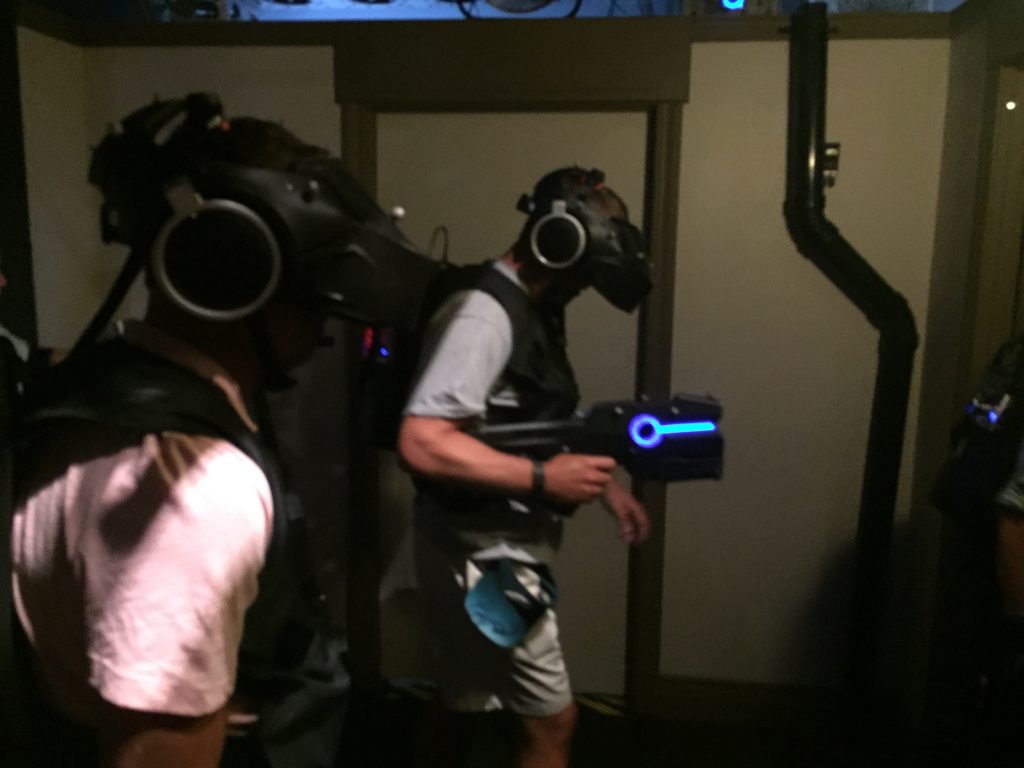
The weight and lack of balance forced us to crank down tightness so hard that it squeezed our heads to the point of discomfort. The group I was in comprised two men and two women, and both women complained of not being able to get the headset aligned so they could see clearly. We had to wait on one of them for about five minutes while the techs tried to make her comfortable, which was probably part of the throughput issue.
When we were finally all set, we flipped down our visors and the staging area instantly became a virtual waiting room. The guns that we were each given became the familiar Proton Pack from the Ghostbusters movies. My fellow Ghostbusters appeared as avatars complete with backpacks and the signature coveralls of the movie characters. The door that separated us from the rest of the playing area was there too, and I reached out to grab the doorknob. I didn’t see my hands reach out, but The Void claims they are going to integrate Magic Leap hand-tracking sensors into their headset in the future which will add another level of realism, as well as offer new interaction methods in the game.
I twisted the knob, the door opened into a new room, and we all stepped in. First thing I noticed was an arm chair next to a window. I went to sit in the chair, but hesitated. What if the chair was only virtual? I reached out and felt the upholstery. Cool! I sat down and peered out the window and could see down the alleyway. All of a sudden a ghost appeared and we all started blasting. The combat with four people in this room was chaotic. The proton packs shoot beams of energy that automatically seek out the ghosts, so aiming is really secondary, which makes up for some of the inaccurate tracking. Some of the ghosts were supposed to be shot at, and I guess some weren’t. We were being given narrative instructions in the game, but between the player chatter and the sound effects, the in-game instructions were almost impossible to follow. Nevertheless, blasting ghosts with our proton packs was super fun.
Nevertheless, blasting ghosts with our proton packs was super fun.
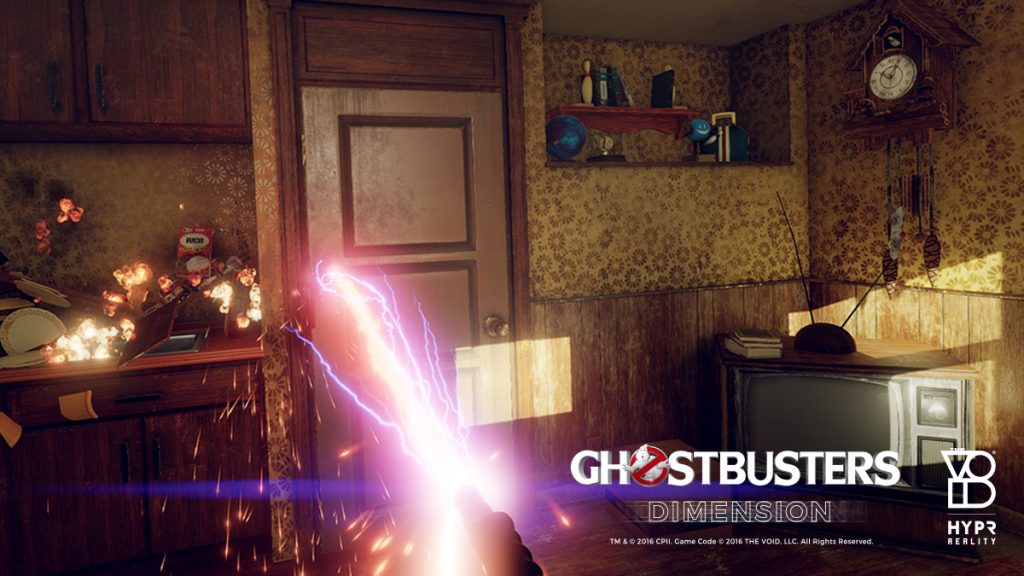 We then moved from this small antechamber into an elevator. This is where the haptics really shone for me, as the floor was vibrating as the elevator climbed up the skyscraper. It was a cool effect and really added to the immersion. When the door opened, Slimer appeared and raced towards us. As he passed through us I felt a mist spray my face and the haptic vest vibrated like he was passing through my body. It was the highlight of the experience for me, though I could imagine some people being grossed out by what felt like being spit upon.
We then moved from this small antechamber into an elevator. This is where the haptics really shone for me, as the floor was vibrating as the elevator climbed up the skyscraper. It was a cool effect and really added to the immersion. When the door opened, Slimer appeared and raced towards us. As he passed through us I felt a mist spray my face and the haptic vest vibrated like he was passing through my body. It was the highlight of the experience for me, though I could imagine some people being grossed out by what felt like being spit upon.
We then walked onto a ledge of a skyscraper overlooking the city. It was a breathtaking scene. I could lean out over the railing to look down towards the street, The platform started shaking and I had to grab the virtual railing so I didn’t fall over. The haptics really added a layer of reality to the experience for me, but most of the other guests I spoke with seemed underwhelmed by it. My supposition is that VR is so new and overwhelming that haptics might be a premature investment, especially when you consider the increased cost, battery impact and reliability issues.
Soon we were battling the Stay Puft Marshmallow Man, and despite Egon’s warnings from the first movie, were advised to cross the streams. As his giant white hand reached down to crush me, he exploded into a a gooey mess complete with the smell of roasted marshmallows.
As we convened after the game, almost everyone agreed that the experience was amazing. One of our group suffered severe motion sickness however. It made her so uncomfortable that she cancelled dinner plans and went home. This is the problem when the tracking system either isn’t accurate, or the frame rate drops. VR is a powerful tool and it’s ability to fool the mind can come with serious side effects. Despite the operational issues and the tracking difficulties, The Void is offering a glimpse into what is possible utilizing Virtual Reality for out-of-home entertainment.
The cost of these installations is not for the meek operator. Free-roam VR systems easily can approach $1 million. The limited throughput is a concern, but at up to $4 a minute, three to four people every 15 mins offers up to $3K per day in potential revenue. Operators will need to get over their aversion to charging a significant premium for what is, at least right now, a very unique, luxury Millennial attraction. Research shows Millennials prefer to spend top dollar for unique experiences over purchasing goods. Zero Latency is charging $88 per person for a 40-minute in-game experience in Melbourne and has been running at over 95% capacity for more than a year.
One of the areas where The Void and Zero Latency differ strategically is the inclusion of fixed objects in the virtual space. While this led to another level of realism at The Void, the operational limitations created by having doors, walls, railings and chairs doesn’t make up for the loss of flexibility of completely changing the experience with the push of a button as they can at Zero Latency. The Void, like laser tag, is more of a physical maze through which the player is guided, where Zero Latency is housed in a big open space with no physical obstacles at all. This affords them flexibility to change from an adults-only, intense, zombie-shooting experience to a platform puzzle game for kids in just a matter of seconds.
I’ve been dreaming of combining laser tag with virtual reality for 25-years, ever since we opened the first joint center with Edison Brothers in 1991. Thanks to the the guys that launched Oculus Rift on Kickstarter, we are now starting to see the reality of that vision. Hold onto your goggles, it’s going to be quite a ride!
Electronic gaming and location-based entertainment veteran (and avid surfer) Bob Cooney has 25-years of experience designing, manufacturing and marketing out-of-home entertainment to consumers, operators and venues –– first as founder and chief executive of NASDAQ- and Inc. 500-listed Laser Storm, and later as an initial member of the Global VR executive team which introduced the first commercially viable virtual reality arcade game. Cooney went on to become VP of marketing and business development of Ecast, the digital content provider for jukeboxes, and COO of NTN Buzztime, the networked trivia game company. Cooney has been a driving force behind the development of numerous top-earning licensed games, including products based on EA Sports PGA Tour, X-MEN and Stargate, and has been a long-time vocal proponent of leveraging new technology to keep the out-of-home amusement industry relevant at a time when in-home entertainment continues to threaten its very existence. Bob consults with companies on strategy and business development. He can be reached at hirebob@bobcooney.com.
